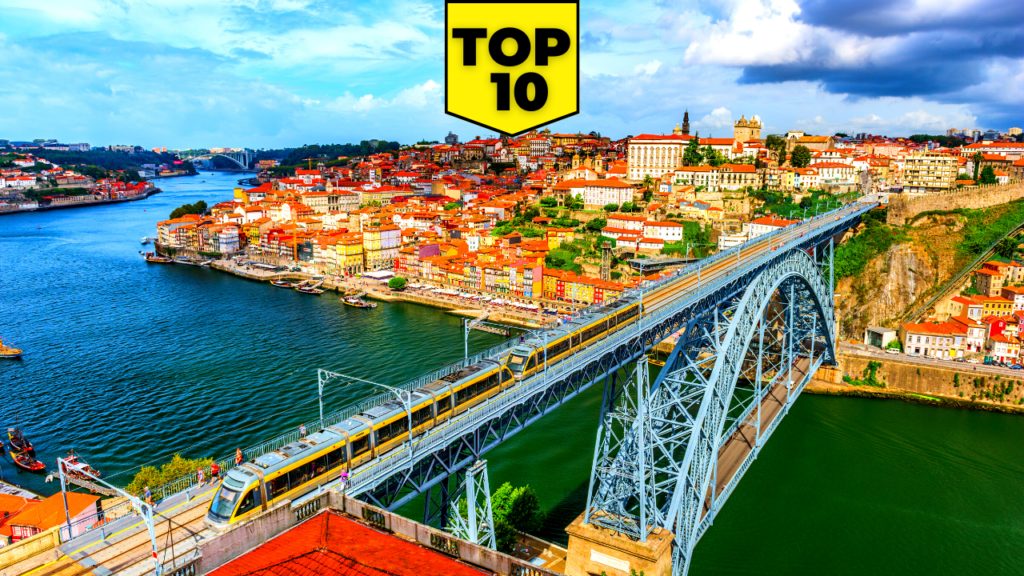
Porto is a relaxed location that effortlessly combines old and modern world charm. It is distinguished by cobblestone slopes, colorful tiled facades, and a fall of terracotta roofs.
Situated at the point where the Duoro River meets the Atlantic Ocean in Northern Portugal, Porto has been a mercantile city since its earliest days as a Roman outpost. Much of the “ancient Porto” may be described as having a definite 18th-century accent.
Let’s take a look at the Top 10 Things To Do in Porto Portugal.
Table of contents
10. Porto Cathedral
The cathedral should always be visited while sightseeing in Porto. In reality, the expansive view of the old-town streets and the peaceful River Douro from the terrace is a wonderful prelude and prepares the senses for what is to come.
The cathedral, an impressive landmark from the 12th century, has the appearance of a fortress due to the towers’ intimidating appearance and the façade’s gloomy color. A stunning rose window from the 13th century located in the west front and the tranquil Baroque cloisters covered in sky blue azulejo tiles are redeeming qualities.
Spend some time here to take in the serene setting and medieval atmosphere. From here, a beaten granite staircase from the 18th century leads to the chapterhouse, which is covered with more gorgeous tile work. The exquisite silver retable in the tiny chapel to the left of the chancel is another noteworthy feature.
To end your journey, explore the magnificent gold and silver collection preserved in the cathedral’s Treasury.
9. Vila Nova de Gaia
With its long, broad promenade and riverfront aspect, Vila Nova de Gaia is an irresistible diversion. Easily reached on foot by crossing the Ponte de Dom Luís I, the town’s landscaped quayside is fringed by a long line of stylish restaurants and cafés.
It’s also the departure point for numerous Douro River cruise boats. The fleet of traditional barcos rabelos docked alongside the esplanade lends a beautiful sense of nostalgia.
With Porto’s Ribeira neighborhood serving as a beautiful backdrop, visitors are treated to an ambient cityscape that is reminiscent of the 18th century. These graceful sailing vessels were formerly employed to transport barrels downriver from the Douro port estates.
Take a trip on the Teleférico de Gaia, or cable car, for a very stunning view. This innovative new tourist destination connects the upper station, which is close to the Mosteiro da Serra do Pilar, with the eastern end of the esplanade along the banks of the Gaia River.
8. Igreja do Carmo
The magnificent façade of Porto’s 18th-century Carmo church is one of the most instantly recognizable in the city.
The exterior is plastered in a blaze of blue and white azulejos The enormous panel definitely draws attention, but the exquisite golden carvings that adorn the interior are equally lovely. The exquisite golden-brushed woodwork is perhaps one of the best representations of Portuguese Rococo.
Less eye-opening is the nearby Igreja das Carmelitas. Amazingly, a house that was constructed to abide by an old ordinance that forbade two churches from sharing a wall divides both.
Despite being vacant for close to 30 years, many consider this to be the narrowest private residence in the nation. The quirky aberration, which is only one meter wide and wedged between two granite monoliths, makes for an intriguing photograph.
7. Cafe Majestic
This glittering jewel of a café is easily recognized by its characteristic Art Nouveau façade of curving stonework and undulating decorations. The salon inside has a retro 1920s feel to it.
The original carved wood seats and marble-topped tables that give Majestic its pleasantly bohemian feel are arranged throughout the opulent space. The plaster ceiling is adorned with cherubs and lamplights. Huge Flemish mirror sets that adorn the walls reflect the setting’s evocative, vintage nature.
This is the most well-known and historically significant café in Porto. There are elegant dining options for both lunch and supper, and the menu tempts with a combination of Portuguese and Mediterranean flavors.
The café is renowned for its collection of cakes and pastries, which includes delicacies like French toast covered in a rich egg custard and sprinkled with dried fruit.
Kids will adore this place, particularly once they learn that author J.K. Rowling drank coffee at a table near the entrance and worked on the first draft of her book Harry Potter and the Philosopher’s Stone. Magical right?
6. Museu Nacional Soares dos Reis
Make sure you go to this museum if you only visit one in Porto. The museum is named for the renowned 19th-century artist António Soares dos Reis, whose sculpture is included in the exceptional collection of Portuguese art that spans the 16th to the 20th centuries. The displays are incredibly diverse in their range, with the gold and silverware being especially captivating.
The paintings in the collection include creations by Portuguese and international painters, particularly Dutch and Flemish. The rare ceramic artifacts include Chinese porcelain, Delftware, and fine pieces of 18th- and 19th-century Portuguese glass.
The tour is given an exotic veneer by decorative pieces of furniture from as far afield as India and Japan, while the textile collection is primarily made up of textiles and other items that were taken from closed monasteries and convents.
5. Torres dos Clerigos
The towering Clérigos Tower stands out against Porto’s background skyline like a colossal needle. The 75-meter-tall, granite-hewn rocket is the city’s most recognizable feature, so seeing this historic building should be top on your list of “things to do.”
You’ll need strong legs to climb the 240 steps to the top of the tower, but the effort will be rewarded with a breathtaking panorama of the river, the coastline, and the far-off Douro valley — an inspiring way for first-time visitors to get their bearings and a bird’s-eye view of Portugal’s second-largest city.
The Baroque tower, created by Italian-born Nicolau Nasoni and commissioned by the Brotherhood of the Clergy, is a beautiful addition to the nearby Igreja dos Clérigos.
Built between 1732 and 1750, the church is one of the earliest in Portugal to have an elliptic layout and is a beautiful illustration of the architect’s fondness for the Baroque style. However, the tower continues to be the main attraction, and day or night, most parts of the city can see its tapered shape serving as a historic beacon.
4. Palácio da Bolsa
The former stock market in Porto, which was built in the middle of the 19th century, is rich in historical significance. Its opulent interior is divided into a number of rooms and salons, each one unique in its appeal and deserving of attentive examination. The building was constructed on the site of a Franciscan convent.
Imagine yourself a wealthy merchant on a business trip as you stroll into the Portrait Room and its gallery of uniformed rulers. Then, as you reach the Golden Room, look upward to take in its gilded stucco ceiling.
You can get ready for your meeting with the boss in the opulent Chairman’s Room before joining other businesspeople in the lavishly embellished Court Hearing Room to observe mercantile law being applied in a fair manner. Before congregating in the beautiful Hall of Nations to mix with the great and the good, you might want to stop at the adjacent Juror’s Room.
The stunning Arabian Room, which was inspired by Granada’s Alhambra, is the only location that actually sells a tour of the Bolsa, so you’ll want to save it for last.
3. Douro River
The Douro river flows for over 500 miles from north-central Spain all the way to the Atlantic Ocean and is the lifeblood of the region.
The Douro, the third-longest river in the Iberian Peninsula, originates in north-central Spain and runs through northern Portugal all the way to the Atlantic coast, where it empties into the ocean at Porto. Many people believe that the name Douro comes from the Portuguese word for “golden.”
The Douro River Valley vinhateiro, one of the oldest wine-producing regions on Earth, is located in Portugal, while the portion of the river within the borders of Spain flows through five provinces of Castile and León.
The region is a UNESCO World Heritage Site and is the origin of the famed Port wine. Port wine was traditionally floated down the river in flat-bottomed boats to be cellared in Porto, but these days, much of the river traffic is cruise boats of all shapes and sizes.
2. Cais da Ribeira
The riverside neighborhood of Porto is a seductive maze of winding, winding streets, zigzagging passageways, and low-slung, sun-starved arcades. The Ribeira is a journey in flavor and color, with terraces of grand townhouses painted in vibrant mustard, tangerine, and tawny hues that face the River Douro.
This is the most well-liked location in the city for unwinding and socializing due to the abundance of eateries and cafés situated beneath the arches along the quayside.
The riverfront area, Praça da Ribeira, is a well-liked gathering place with dynamic, youthful energy. Additionally, this is a bustling business area where butchers, fishmongers, and grocery stores coexist.
The sound of cobblers’ hammers tapping away in tiny, abandoned shoemaker’s workshops reverberates, and the rustic aroma of freshly baked bread mingles with the Douro’s salty, briny scent. Above it all, folks shout across lines of washing that are snaking in the wind as they converse from balconies or open windows.
Exploring this fascinating area will allow you to find medieval remnants that were erected on top of Roman ruins. The Ribeira is also about history. The area is adored by UNESCO, who long ago designated it a World Heritage Site.
1. Ponte Don Luis I
One of Portugal’s most famous landmarks is the opulent Dom Luis I bridge. The bridge’s majestic sweep and two-tiered design, which spans the huge River Douro to connect Porto with Vila Nova de Gaia on the south bank, form a crucial part of the strong social fabric of the city.
The strongly riveted charcoal-grey ironwork screams Gustave Eiffel, and in fact, it was the legendary French engineer’s assistant who constructed the bridge in 1886.
Daily commuters use the bridge, which has a road called Avenida da Republica across the lower deck and a metro rail line in the top span. If they’re feeling very daring, they can stroll across the structure on the top-tier pathway, which is 60 meters high, instead of the tiny sidewalks that are set up on either side of the road.
The Mosteiro da Serra do Pilar’s balcony on the south side offers a breathtaking view of the bridge. The entire city provides an amazing backdrop from this vantage point, and the scene is especially spectacular after nightfall.
Conclusion
This UNESCO World Heritage town with fantastic amazing views from the hills overlooking Douro River should definitely be on your list if you like good food, fantastic wine, museums, and historical churches.
The list above doesn’t include all the reasons why you should visit Porto, however, they provide a good sense of what to expect when visiting the city. There are many other great attractions like the Jardins do Palacio de Cristal, Museu Serralves, Casa da Musica, Rua Santa Catarina, Parque da Cidade and many others
Did any of our picks above catch your attention? Which one would you consider visiting on your trip to Porto?



